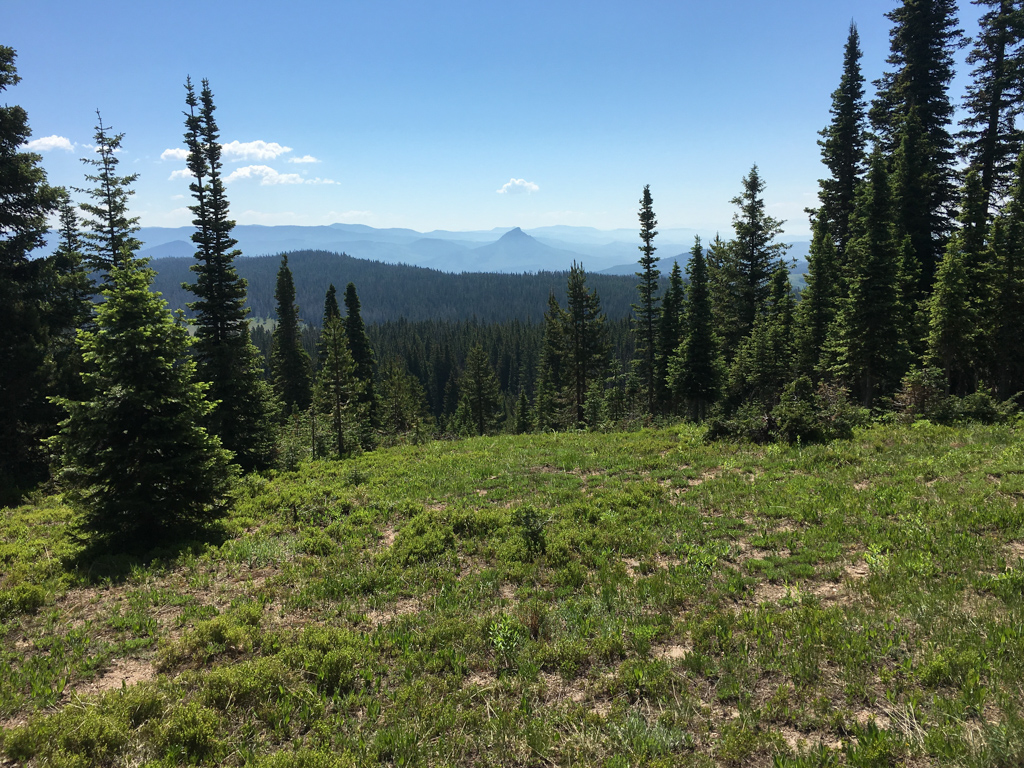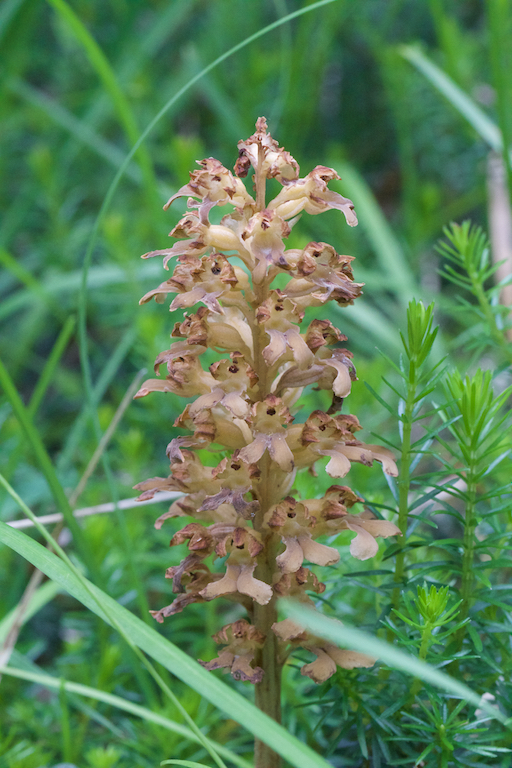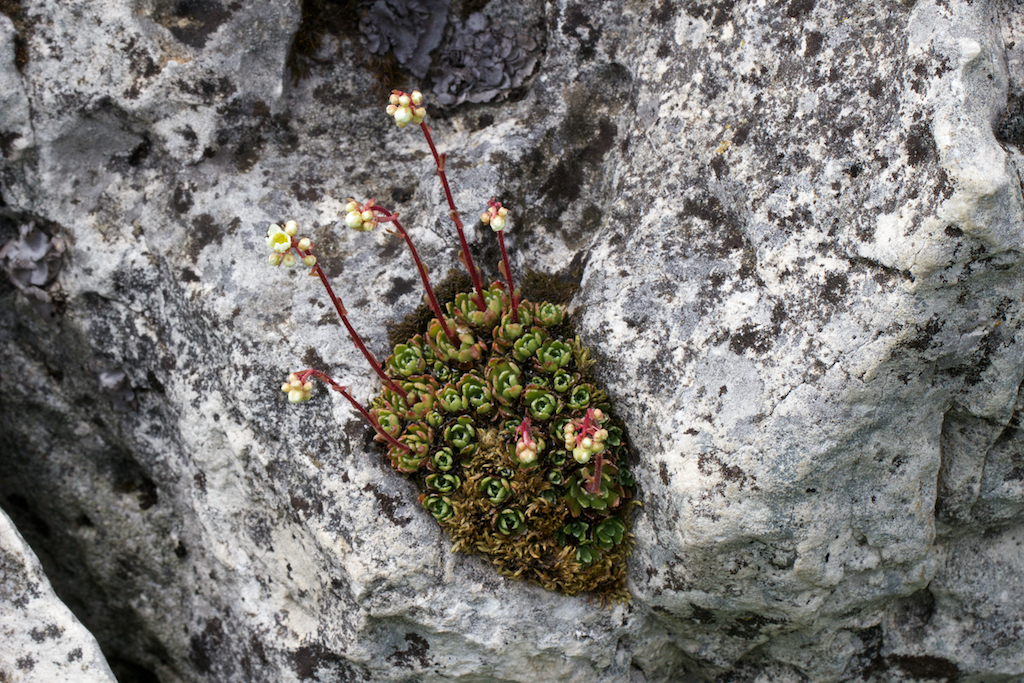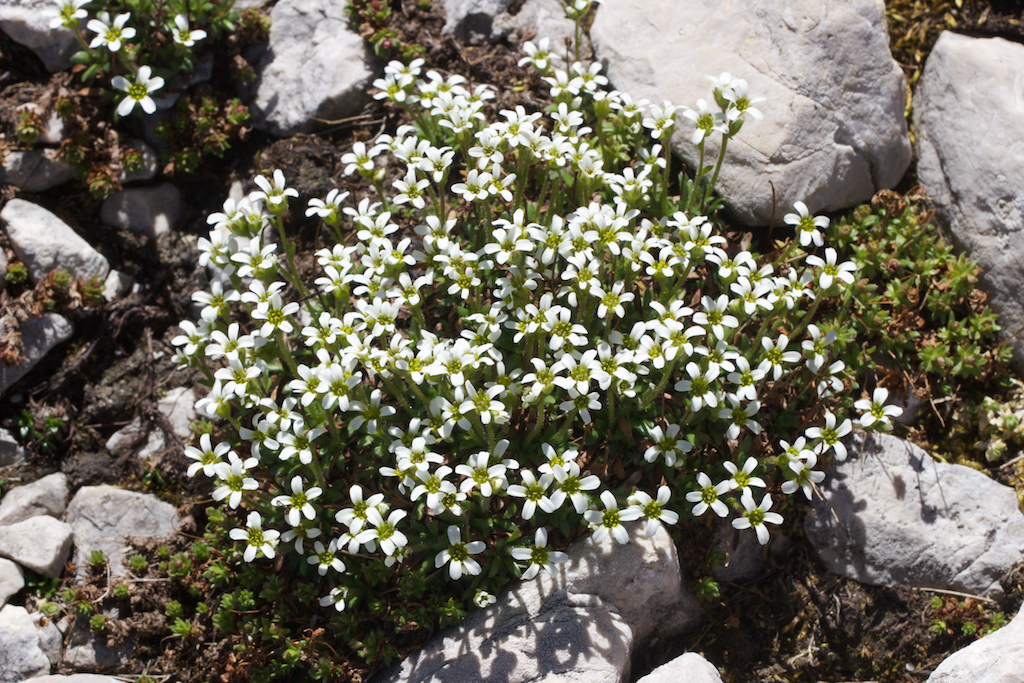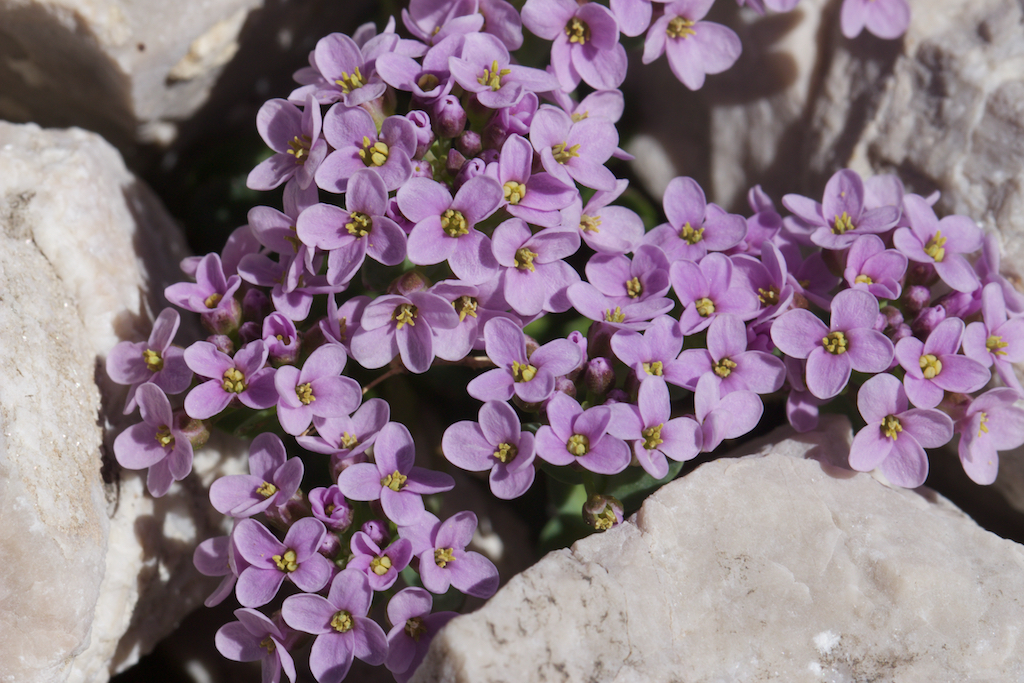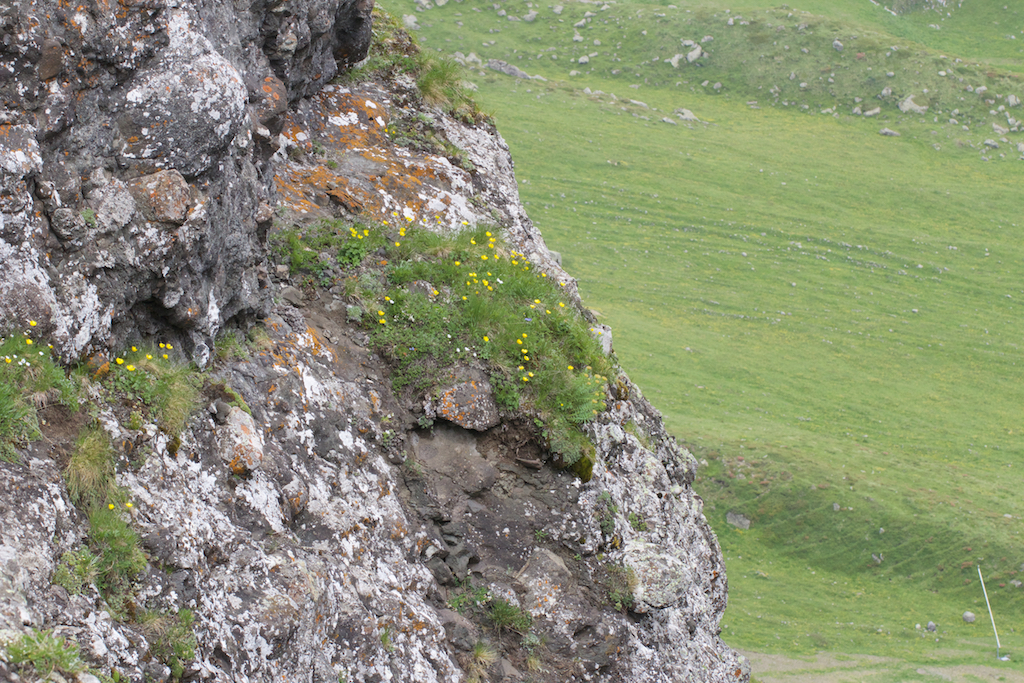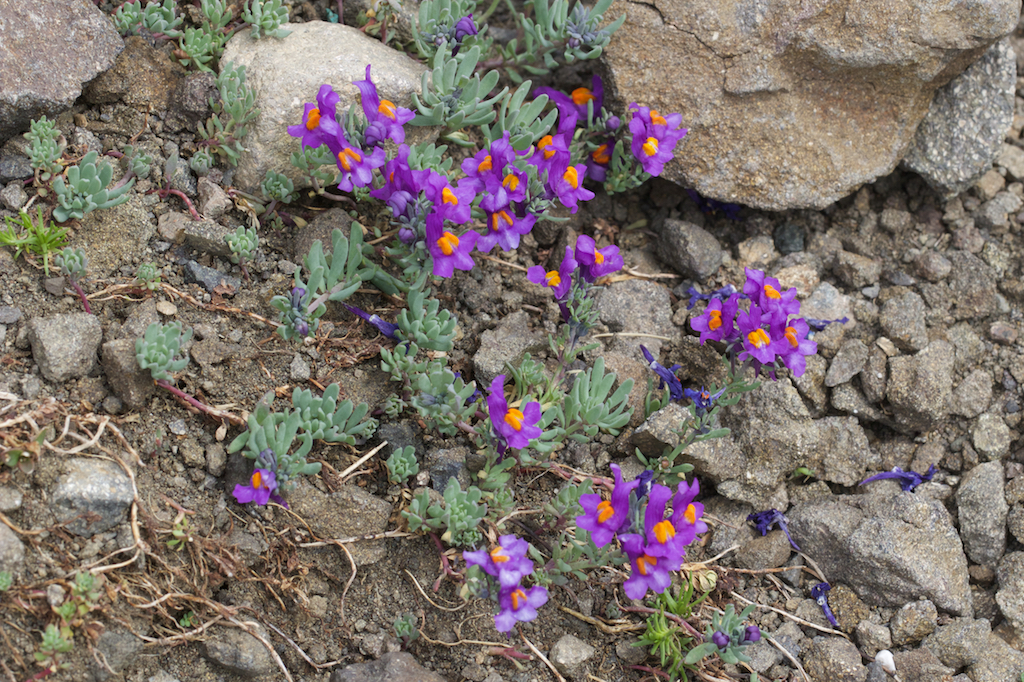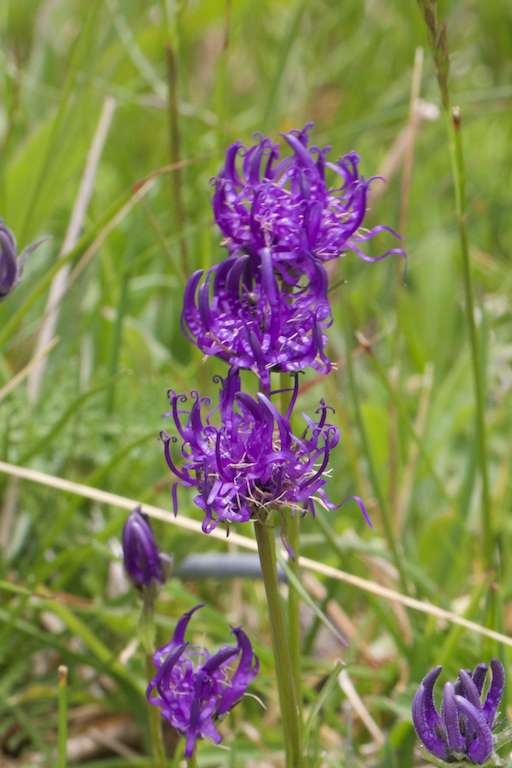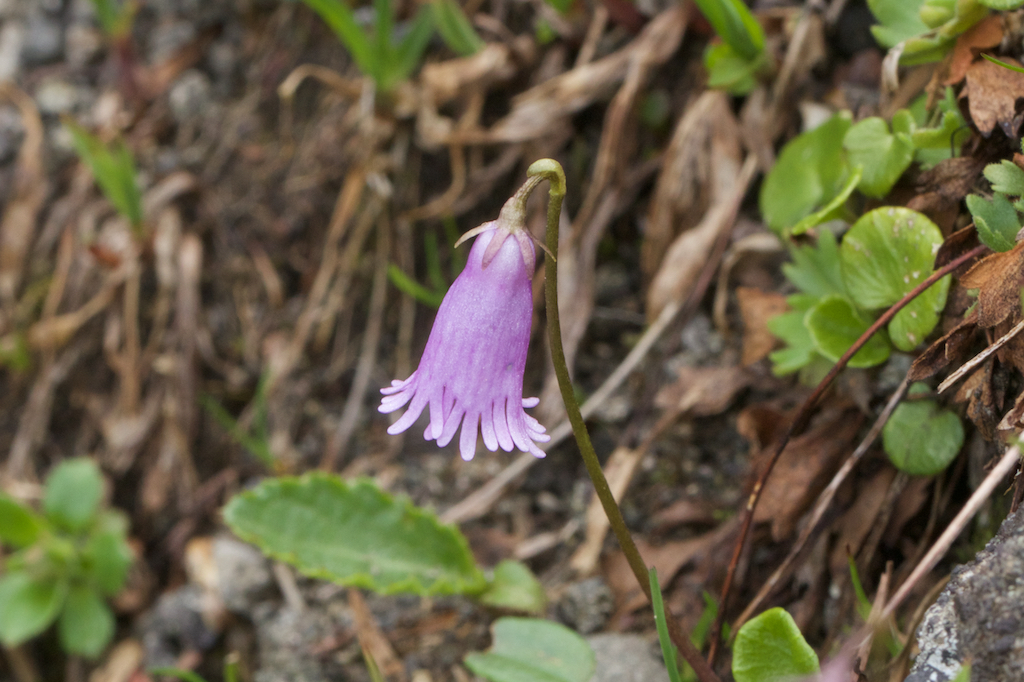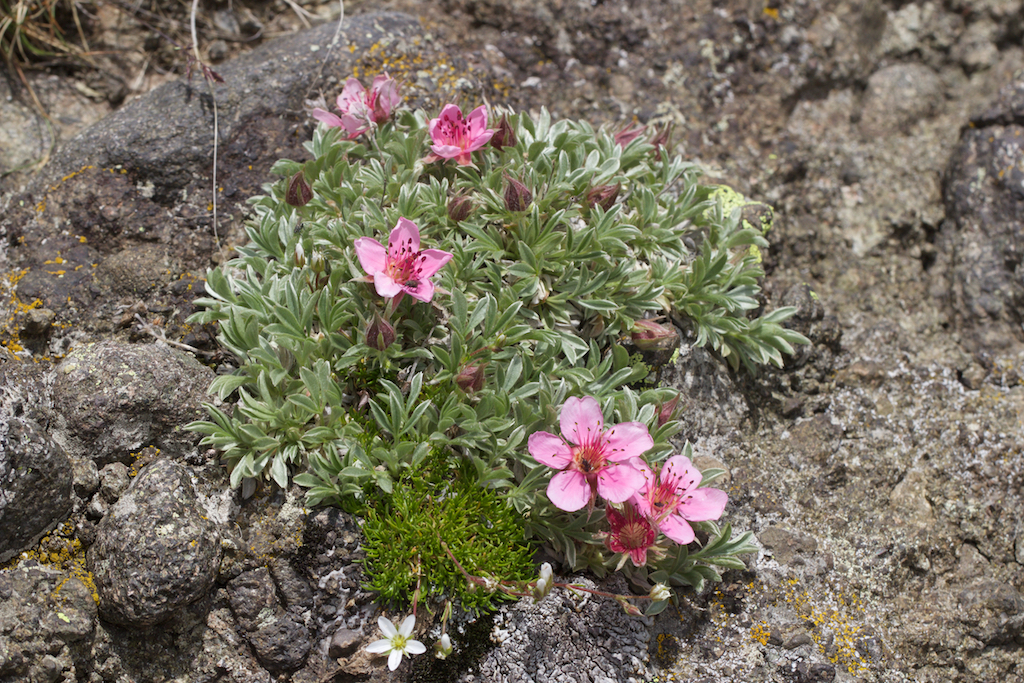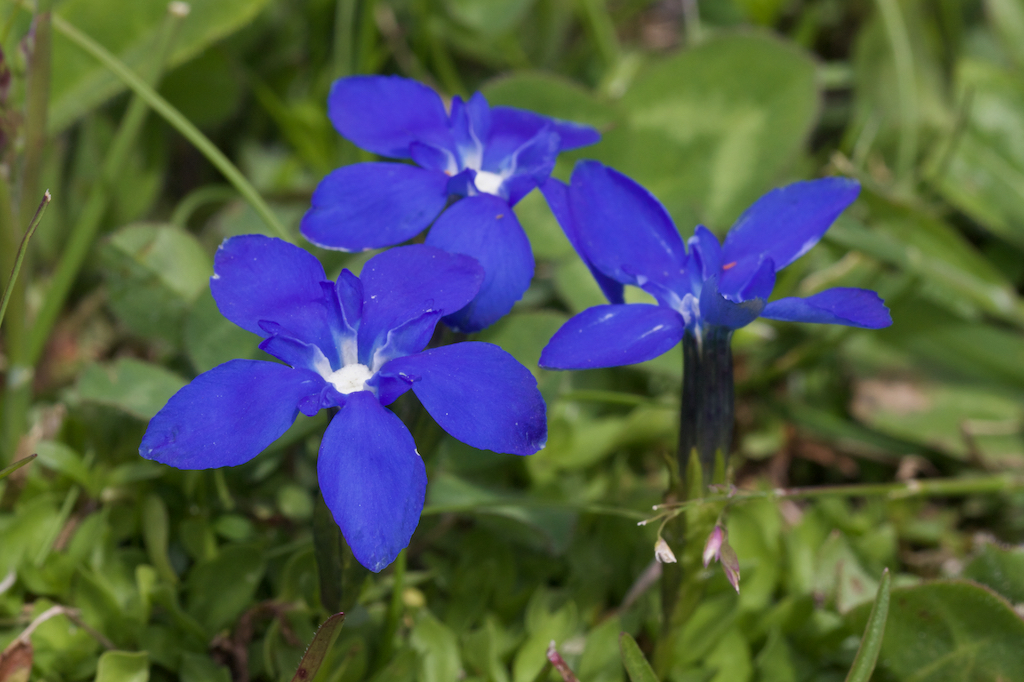It’s appropriate to feature a zinnia for this Garden Blogger’s Bloom Day post because they are all over the place — in vegetable garden, by the driveway, and in the orchard. It’s hard to disagree with a flower that comes from seed so easily and lasts all season long. In fact zinnias were the first flower we planted when we got inspired to start gardening fifty years ago. We read a book by Jeanne Darlington (Grow Your Own) that led us to scratch a little garden plot next to our student housing. There have been a lot more flowers since …
Typically we have Dahlias and Glads in the vegetable garden just for picking.
And son Josh planted a lot of wildflowers around the property this spring.
Including especially zinnias and sage in the orchard, but also this particularly pretty variety of basil.
My eye tends to get distracted by the perennials, especially those that are giving a bonus rebloom.
There is also a nice little patch of Colchicum in with the wildflowers in the backyard.
As you walk down the driveway it’s hard not to notice the Viburnum with it’s berries hanging out into the drive.
In the greenhouse I found the Scilla maderensis budding up a few days ago.
And now the flowers are opening up.
This is also the oxalis time of the year.
One after another, the Oxalis break into bloom from early September into February.
I’ve also found myself reading up about Zephyranthes and their close relatives Habranthus. These are both part of the Amaryllis family and they are spectacularly easy to grow. They are often called rain lilies because the rapid appearance of the flowers in late summer. I’ve had the yellow forms (like Zephyranthes smalli and Z. jonesi, or Habranthus texensis) for a number of years, but what I’m discovering is that the pink and red forms of the family are really special.
This little Habranthus has white flowers that are tinged pink on the outside.
And these two Zephyranthes are both of the pink persuasion mixed with white.
This last one is especially large for a Zephyranthes. It was found in Mexico on a red mountain, therefore it’s name. Most of the Zephyranthes prefer a southern climate (say zone 8), but they are easy to overwinter in a pot. They make abundant seeds which will start popping up in other pots if you don’t pay attention. I’ve got a number of pots that I thought were tritoma or babiana or some other bulb, only to realize that they were actually Zephyranthes volunteering to use an empty pot.
Garden Blogger’s Bloom Day September 2017
Well, it’s fall here in Maryland and some of the usual suspects are providing our flowers for Bloom Day. Japanese anemone are robust and reliable, as well as incredibly beautiful.
Some of the other regulars are in the following pictures.
In the wildflower patch, the wild asters are currently the star of the show, attracting insects of all sorts.
In the cutting garden the standouts are the Tithonia.
Beth has shown they look really nice next to the Salvia ‘Black and Blue’. They are also quite tall so it’s easy to see them from underneath as well.
A similar color comes with the Atlantic Poppy which took forever to start blooming but now has a new flower every day.
Inside the greenhouse we have blooming for the first time the Scilla maderensis. It seems to open just a few of the flower elements per day so that it’s never completely in flower for us.
It is nevertheless interesting and exotic which goes a long way to getting space in the greenhouse.
The first of the Oxalis are coming into bloom now.
There are three species blooming now, but the rest will extend the blooming season into January at least.
It’s worth noting that one does not live by flowers alone. The garden fruits and vegetables have been abundant this year, pushing us to new recipes and uses for the crops…
Jewels of Spring
It’s that time of year when I wish each day would linger so that we can enjoy all the jewels of springtime that are popping up day by day. I’m so busy outside that I’ve not kept up with recording all the flowers coming into bloom right now. The spring ephemerals are always at the top of my enjoyment list. Many of them are small, transitory, and wonderfully beautiful. Hepaticas come to mind with their small hairy leaves and colorful stamens.
But there are many competitors for my eye. Here are a few that have come in the last few weeks.
This is a new plant grown from seed obtained from the Scottish Rock Garden Club seed exchange last year.
A new addition from Augis Bulbs last summer.
Of course, even in springtime the greenhouse is contributing it’s part.
A wonderful plant. I have some outside as well and last year they managed to flower.
This comes on a 3 1/2 foot stalk. I’m going to try putting it outside this year. It’s marginally hardy in our area and it would be wonderful if it succeeds.
And then lastly the greenhouse provided a lot of color to the house
A Higher State (Steppe to Alpine)
We just returned last week from a spectacular trip to Colorado that was focused on the North American Rock Garden Society‘s (NARGS) annual meeting. The theme was ‘A Higher State — Steppe to Alpine’ and it was in two locations, the Denver Botanic Garden and Steamboat Springs over 5 days. It had been a while since we had been to Colorado, so we met with friends and family in Boulder and Golden beforehand. I’ll try to give a brief overview of what was a wonderful and relaxing exploration of mountain wildflowers.
Hiking just outside of Boulder we encountered this lovely Calochortus.
The NARGS meeting began at the Denver Botanic Garden where we got a personalized tour of the rock gardens by Mike Kintgen who oversees the Alpine collection.
Their garden features a crevice garden which has been established for several years now (long enough to see several successful cushions)
They manage to grow the wonderful Devil’s Claw that we first saw in the Dolomites last year.
The Denver Botanic Gardens are not to be missed if you are in Denver. In this season they have a spectacular display of Foxtail Lilies.
On our way to Steamboat Springs we stopped at the Betty Ford Alpine Gardens in Vail which has newly constructed tufa wall for optimum planting of tiny alpines.
And the outside part of the gardens is quite nice as well.
In Steamboat Springs we visited local gardens including the Yampa River Botanic Park which right along the Yampa River in a very pretty setting. They have built a stunning crevice garden there.
I fell in love with a little Stachys planted in one of the crevice locations.
We also took several hikes in the trails surrounding Steamboat Springs. We drove out through countryside that really summed up what steppes are all about.
Just along the side of the road we saw beautiful Lewisia and Shooting Stars.
One stop near a trailhead into the Zirkel Wilderness area produced a bevy of these very small Ladyslipper Orchids
We stayed a few days past the conference and on the last day of hiking we walked up a ridge near the Rabbit Ears pass area. The views were excellent, but it was remarkable how you had to pay close attention to see that the hillside was covered with wildflower treasures.
And a final sighting on this ridge was a very nice ground orchid.
All in all, a wonderful trip, with a suitcase full of tiny treasures brought back to Maryland from the plant sales at the conference. My thanks to Laporte Avenue Nursery and Sunscapes Rare Plant Nursery.
Also, I should mention that the Denver Botanic Garden has published a very nice book on this region of the world (and similar) entitled ‘Steppes: The Plants and Ecology of the World’s Semi-arid Regions‘. Check it out…
Why Alpines Inspire
We’ve been back a little more than a week now from a wonderful exploration of the Dolomites with Greentours. We spent our days walking through meadows or scrambling up rocky cliffs finding hundreds of species of wildflowers in bloom.
The whole experience was a reminder of why alpines are so captivating for gardeners all over the world. Their relatively short growing season and difficult exposed conditions has produced adaptations characterized by rapid abundant flowering from compact plants that are often nestled in or on rocks where many other plants cannot grow. Of course it doesn’t hurt that the scenery is glorious whenever you take the time to look up from the plants.
The trick is to learn where to look for the different species. Meadows are often filled with various small ground orchids in the same way we would expect to see dandelions in Maryland. Potentilla, Sage, Thyme, and Ranunculus are abundant.
The interplay with the rocks mean that you often seek out rocks in a field to see what has colonized the rocks. Of course Saxifrages are particularly good at this.
But in between you find other treasures like the famous Edelweiss.
The Rampions were a particular favorite of mine. The Round-headed Rampion was found in many locations.
And on three occasions we came upon the famous Devil’s Claw in flower. This alpine flower is found only in Italy, Austria, and Slovenia and we were fortunate to actually be there when it was flowering.
The Physoplexis seemed happiest when growing on a cliff face. It immediately produced a question in our group which apparently has been a serious question for botanists. Namely, how does the Devil’s Claw get pollinated?
Another particularly beautiful flower, like the Rampions, is also in the Campanula family.
Mostly we explored the areas around the mountain passes, but we also got to higher elevations on two occasions. One I wrote about on the previous posting and the other was on the next to the last day when we took a ski lift up to the shoulder of Marmolada at 8500 ft. The ground at the top is all scree below the snowline and at first you would conclude there is nothing gowing there.
But on closer inspection you see that many things thrive in the scree.
Especially prevalent was the Round-leaved Pennycress which seemingly colonizes every spot where someone else is not…
Dolomitic Joy
We are experiencing a wonderful surplus of wildflowers this week on a tour of Dolomites with Greentours. I hadn’t intended on reporting on this journey until we returned home but today was such a wonderful experience I just had to share some of what we have been seeing. Every day has been a discovery of new plants that we had never seen, with hundreds of species recorded so far, but today was just over the top for anyone interested in alpines.
We spent the day walking at over 7000 feet looking over majestic scenery and crawling up crags to get close to cushions of alpine plants or walking next to meadows where flowers and butterflies were abundant. I’m just going to share a few of the images at this point to give a sampling of what we are seeing but for anyone who is interested Greentours does a phenomenal job of giving you a rich and thorough exploration of the landscape. We’re on the trail from about 9 to 5 every day and each day seems to exceed the last in wonderful experiences. I expect to provide a more complete sampling of the wildflowers in the future but this is a sampling of today’s encounters.
Last, but not least, we have encountered a number of Gentians and several have the stunning blue color that Gentians are famous for. It seems appropriate to begin with the blue Eritrichium and end with a Gentian.
Amidst the Rain
I returned this afternoon from another short trip with the rain coming in spurts for the rest of the afternoon. We had had a bird bath full of rain while I was gone and the Hepatica and Shooting Stars that we planted in the woods this past weekend seem to be doing fine. What I did find in the front yard were some Fritillaria that seemed to be enjoying the rain.
I also noticed quite a number of flowers appearing on the little Rue Anemone.
And the violet version of the Chilean Crocus has finally shown it’s face.
In between rain showers I also went down into the woods to check on the Bellworts.
I keep being nervous the deer will find these little beauties, but so far, so good.
While in the woods I discovered a particularly nice set of daffodils growing next to the old bench.
As it turns out these are tazetas that are not even supposed to be hardy here.
Usually these are grown in the south or for forcing.
Here’s my harvest from the walk through the daffodils that are coming in right now.
We bring in a batch like this every other day and there are still many more outside.
Garden Bloggers Bloom Day for November 2010
Well this November Bloom Day finds us with a limited number of flowers and a powerful number of brilliant fall leaves. We have had an extended sunny autumn with many of the plants making a comeback as they (falsely) assume that the cold weather will never get any worse than the 28 degrees that we’ve seen now and then this fall. It’s been altogether a great time for fall bulb planting (all completed this week), garden chores (never complete), and photography.
The few flowers that let us still claim this as bloom day are the Gallardia, some random snapdragons, a few bedraggled salvia, and some very nice little Calendula.
There are a few other sources of flowers besides the perennials though. In the pasture the dandelions have had a rebirth and I’ve also seen the Yellow Toadflax showing it’s cute little butter and eggs flowers.
Another plant that persists in flowering beyond all reasonable expectations is the Loropetalum. I first saw this plant in a posting from Les at A Tidewater Gardener. It has already grown rapidly from 1 gallon plant this spring to a fairly decent sized shrub with pretty fuschia flowers that have strap-like petals. The question will be how it survives our winters. Stay tuned…
One other source of flowers are the plants we’ve brought inside in pots. A particularly lovely violet shade is on the bougainvillea which is happily flowering (or what passes for flowering on a bougainvillea) in the basement.
The various grasses have yielded their seed heads, some more colorful than others. I couldn’t help noticing the fine scale of the pink muhly grass since Beth has brought several stalks into the house.
But the real color of the season is the leaves. Everywhere you look there are various shades of leaves doing their thing. The gigantic Red Maple in the backyard has turned a vivid yellow this year. And it contrasts nicely with the other maples.
Depending upon the light in the morning or evening the outline of the Japanese Maple leaves against the sky can also be quite artistic.
The japanese maple leaves are also quite persistent as we move toward winter.
Speaking of persistency, one of my favorite trees in the forest is the American Beech. The leaves turn from golden to a warm brown shade and last well into the winter.
Although they stand out even in a mixed forest, if you can find them in a grove setting it can be perfectly wonderful. We have one such grove along one of the trails at the Worthington Farm, a part of the Monocacy National Park. It is a delightful, almost mythic place, at any time of year. But in the fall it really comes alive with golden yellow-brown. Seek such a grove out and treasure it.
Go to May Dreams Gardens for other Garden Bloggers Bloom Day posts…








































































